
I haven't seen this on any other score, which at least maintains a consistent treble clef design. Is there a specific reason why they wouldn't just use the same treble clef punch on all the staves?

Yes, I noticed several 2nd Viennese school scores to be engraved so. Some of Boulez pieces for Universal Edition were done by that technique as well.
As far as I can see, the beams are ruled and the stems are straight. (I'm not considering the roughness of the scanned image.)John Ruggero wrote: ↑13 Mar 2017, 23:46 That is very nice, although somewhat idiosyncratic hand copying; it is definitely not autography. The beams are not ruled, the stems are not straight, the accent marks and tremolo marks are all over the place. The symbols all vary with each repetition.
Autography was done on a drawing board; every line was ruled to perfection, like an engineering drawing, and anything hand drawn was done with much greater accuracy than in the example. I wish I had an example to post. It had almost the precision of very fine engraving.